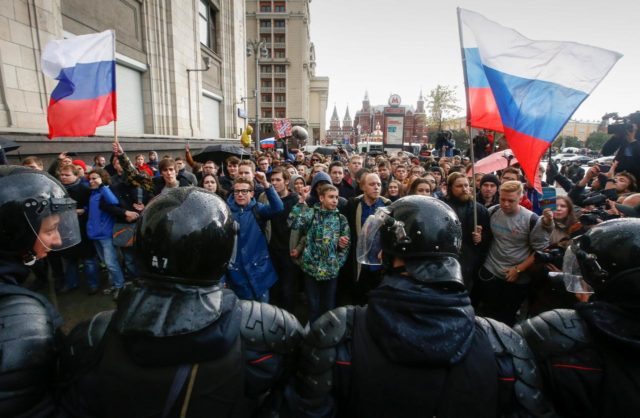
Navalny Organizes Another Round of Protests Against Putin
Publication: Eurasia Daily Monitor Volume: 14 Issue: 127
By:

Ostensibly to celebrate Vladimir Putin’s birthday on Saturday, October 7, supporters of the detained opposition politician and anti-corruption blogger Alexei Navalny and his staff organized protests across Russia, calling on the Russian president to leave office. Navalny himself has been under administrative arrest since September 29, and so was unable to attend the protests. These latest were the third sizeable protests this year under Navalny’s opposition umbrella—the first being in March (see EDM, March 27) and the second occurring on June 12. As usual, the largest protests took place in Moscow and St. Petersburg. “[O]n behalf of the 163,171 campaigners and 623,621 petition signers for the nomination of Navalny,” his staff called for “all those, who want a better future for our country, regardless of political views and agreement with Alexei Navalny’s program, to act as a united front for political competition and the right of all citizens to support the campaign that they like” by coming out onto the street for the latest protests (Navalny.com, October 5). First among the protesters’ formal concrete demands was a call to have Alexei Navalny’s candidacy admitted to the March 2018 presidential election. Although numbers attending the demonstrations were significantly lower than previous rallies, they nevertheless achieved a truly country-wide presence.
In Moscow, between 700 and 3,000 protestors gathered at an unsanctioned event on Pushkin Square, with banners reading “Happy Birthday Vova! [The diminutive form of Vladimir, a reference to Russia’s President],” “Navalny is our President!” and “Russia without Putin!” The protesters then marched down to the Kremlin. In St. Petersburg, between 8,000 and 10,000 people gathered at the Field of Mars at 5:30 pm and marched to Revolution Square, where the meeting proceeded for another two hours (Novaya Gazeta, October 7). Although the crowds at each event were smaller than those seen in June and March, they were still sizeable and perhaps testimony to the popular desire among certain segments of society to see Russia free from Putin. Other protests proceeded in a reported 80 different cities around the country. An estimated crowd of up to 2,000 gathered in the city of Yekaterinburg, and dozens assembled for protests in Izhevsk, Rostov-on-Don, Krasnodar, Kaliningrad, Saransk, Samara, Tomsk, Pskov, Lipetsk, Tyumen, Tula, Yuzhno-Sakhalinsk and many more (Newtimes.ru, October 7). Although the numbers of protesters may be small, when weighed against the difficulties of managing street demonstrations across the world’s largest country, in the shadow of the authoritarian regime that has arisen in Russia, their sheer existence is itself impressive. Evidence also exists of the authorities taking preventative moves ahead of the protests, by detaining and creating trouble for members of Navalny’s regional staff. For example, in Rostov, the chief of Navalny’s regional operation, Anastasia Deineka, was arrested without official reason by the E-center for countering extremism in the region. Similarly, the chief of Navalny’s headquarters in Smolensk was arrested and given an eight-day sentence prior to the October 7 protests (Newtimes.ru, October 7). Against this background, the authorities’ relatively tolerant reaction to the actual protests makes sense.
As of Sunday morning, some 271 people had reportedly been arrested in 26 cities across Russia (Ovdinfo.org, October 8). Sixty-two people arrested were in St. Petersburg, 57 in Yaroslavl, 21 in Krasnodar, and 20 in Lipetsk. Smaller numbers were also detained in Kaliningrad, Perm, Pskov, Saransk, Selyatin, Sochi, Stavropol, Tula, Tyumen and Yakutsk. The demonstration in the city of Moscow was striking: Novaya Gazeta christened the action the “first [protest] in Moscow without arrests” (Novaya Gazeta, October 7). Most of those arrested were ultimately released; but as of Sunday, October 8, there were still some small protests active in Moscow and St. Petersburg, calling for the release of those remaining in police custody. According to reports, the protesters in Moscow turned out with mattresses and food, looking determined to stay as long as needed on Manezh Square in order to force the authorities listen to them. The protests broke up after police arrested and then released 15 people with whom they had held a short preventative conversation (Newsland.com, October 8).
The protests appear to have been equally pro-Navalny and anti-Putin. On the one hand, the almost certain announcement by Putin that he will be seeking a fourth term [second consecutive, following the rukirovka [castling] with Dmitry Medvedev in 2008) will come soon. Navalny has a clear incentive to keep the momentum of demonstrators at high levels ahead of this announcement, which presumably will be met by protests just as Putin’s 2011 announcement of his intent to return to the presidency was. On the other, Navalny is still trying to get on the ballot for 2018, as is stated on his website. Still, while he has a certain popularity with some sections of Russian society (in particular, the young), it is difficult to see how he could defeat Putin at the ballot box, even in a fair electoral contest. Social scientists have provided evidence that Putin’s popularity is genuine, after all (Timothy Frye, Scott Gehlbach, Kyle Marquardt, and John Ora Reuter, “Is Putin’s Popularity Real? Post-Soviet Affairs, 2015). Given this, one might think it wise for the Kremlin to provide the semblance of competition and evidence of its democratic pretensions by letting Navalny run. But doing so now would risk the impression that the regime will make concessions to street mobilization.



